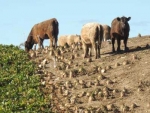Blood and autopsy samples from cows that were sick or died after grazing swedes in Southland last winter have confirmed liver damage but the role, or not, of the HT strain of the crop in the epidemic is still unclear.
“While the study did not allow comparison between swede varieties, the findings indicate that cows experienced liver damage after grazing swede varieties other than the HT (herbicide tolerant) variety, regardless of whether there were visible signs of illness,” said Dairy NZ’s regional team leader Richard Kyte in a media statement released December 23.
Last week Kyte declined to reveal the data behind that statement for fear of wrong or invalid conclusions being drawn from what was “just one bit of data” in the ongoing investigation.
“These samples were from just 15 farms late in the piece and we have no further information on these farms at this point so this data really is in isolation,” he told Rural News.
It was known which cultivar the animals sampled had been grazing but the differences between them were not significant and no further scientific conclusions could be drawn, he added.
The next step in the investigation is to collate and analyse data from an in-depth survey of 120 farmers and their graziers.
“We have interviewed farmers across the region, those affected and unaffected by the issue, to help us understand whether farm management practices may have been a contributing factor….
“We have also sought permission to access their relevant veterinary records. These could provide a wider dataset and help us understand the illness better and give us valuable insights into what happened.”
Analysis of the survey data has started and findings are expected in March.
Kyte says it’s too soon to say whether there’s been an impact on reproductive performance, as some feared, as reproductive data isn’t yet complete. Results could also be skewed by Southland having had “a shocking spring”, but analysis of additional blood samples is underway to assess if and how affected cows have recovered. Results are expected by the end of next month.
Analysis of plant samples taken from crops that caused problems, and those that didn’t, should get underway soon, he adds.
“We are working with New Zealand plant breeders and laboratories to ensure we use a consistent methodology for the analysis of the plant samples. That’s vital to ensure we get some robust and useful information from that work.”
The blood and autopsy sample results indicate liver damage similar to that seen in facial eczema. Visual symptoms in the cow, such as the photosensitivity seen in the swede cases, occur after the liver has been damaged, notes Kyte.
“We’ve reviewed the published scientific data on this topic. It supports the possibility that substances in the swedes caused this disease (see panel)….
“However, we have to be careful about drawing any major conclusions from these findings. The analysis is based on samples collected at a single point in time towards the end of the period when the illness was evident. They were not collected over the whole swede grazing period.
“Additionally, only a selection of swede varieties was represented in the animal samples taken. The possibility of an unknown toxin causing this can’t be discounted.”
Brassica poisoning
All brassica varieties produce a range of sulphur-containing substances (pre-toxins) such as glucosinolates and SMCO (S-methylcysteine sulphoxide) which are not toxic in themselves, says Kyte. Brassica pre-toxins are changed during rumen digestion into toxic agents such as nitriles, which are known to cause liver damage in rats. Levels of glucosinolates and SMCO in plants can be affected by plant growth conditions and are generally highest in mature plants and flower heads.
Swede story so far
• Winter/spring 2014: hundreds of cows grazing swedes in
Southland die, many others sick (Dairy News, September 23)
• HT variety implicated, but possibly simply because
it was most widely grown.
• Working group formed, including Federated Farmers’,
veterinary, seed industry, and Dairy NZ representatives,
formed to investigate incident.
• December 23: first blood and liver sample analysis announced shows liver damage consistent with brassica poisoning
but no variety link.



















